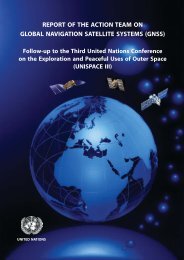Proceedings of the Workshop - United Nations Office for Outer ...
Proceedings of the Workshop - United Nations Office for Outer ...
Proceedings of the Workshop - United Nations Office for Outer ...
- No tags were found...
Create successful ePaper yourself
Turn your PDF publications into a flip-book with our unique Google optimized e-Paper software.
MAINTAINING THE SPACE ENVIRONMENT 199considered, besides <strong>the</strong> IADC, also by <strong>the</strong> InternationalAcademy o f Astronautics, IAA, representing <strong>the</strong>scientific community. The Report will be fur<strong>the</strong>rconsidered by <strong>the</strong> Committee on <strong>the</strong> Peaceful Uses <strong>of</strong><strong>Outer</strong> Space, COPUOS. That committee will decidewhat fur<strong>the</strong>r steps should be taken in dealing with <strong>the</strong>problem o f space debris.The Report concludes2: "Space objects withdiameters larger than 10 cm in LEO and larger than1 m in GEO can be observed and tracked. More than8,500 catalogued objects are in Earth orbit. Thenumber o f in-orbit catalogued objects has beenincreasing at a relatively linear rate fo r <strong>the</strong> pastseveral decades. ... The trends and tendenciespredicted fo r <strong>the</strong> future orbital debris environmentare qualitatively in agreement ... The limitation o fmission-related debris and <strong>the</strong> prevention o faccidental explosions have been found effective andhave already been introduced to some extent. Also,<strong>the</strong> transfer o f GEO spacecraft into disposal orbits at<strong>the</strong> end o f <strong>the</strong>ir active life is already customarypractice. ... For some satellites on long lifetime LEOorbits, a transfer to shorter lifetime orbits is plannedat <strong>the</strong> end o f <strong>the</strong>ir active life. Such procedures, ingeneral, could be most effective. ... Since most o f <strong>the</strong>mitigation measures introduce some burden tomissions, it would be beneficial i f <strong>the</strong> same mitigationprocedures are considered globally. ”“In most cases, man-made space debris todayposes little risk to <strong>the</strong> successful operations o fapproximately 600 active spacecraft now in Earthorbit. However, <strong>the</strong> known and assessed population o fdebris is growing, and <strong>the</strong> probabilities o f potentiallydamaging collisions will consequently increase.Because o f <strong>the</strong> difficulty o f improving <strong>the</strong> spaceenvironment with existing technologies, <strong>the</strong>implementation o f some debris mitigation measurestoday is a prudent step towards preserving space fo rfuture generations .... ”Questions arising from <strong>the</strong> growing number <strong>of</strong>satellites in orbit have been also considered by <strong>the</strong>Fifth International Space Cooperation <strong>Workshop</strong>“Solving Global Problems”, organized by <strong>the</strong>American Institute <strong>of</strong> Aeronautics and Astronautics,AIAA, was held at Bermuda, 11-15 April 19993. Theworkshop adopted several recommendations whichhave been presented recently to <strong>the</strong> Technical Forum.This session can ei<strong>the</strong>r express its support to some <strong>of</strong><strong>the</strong> recommendations or it can <strong>for</strong>mulate its ownrecommendations. For <strong>the</strong> convenience o f this session,selected recommendations o f <strong>the</strong> AIAA workshopfollow:1. On <strong>the</strong> work <strong>of</strong> <strong>the</strong> COPUOS done withassistance o f <strong>the</strong> IADC and <strong>the</strong> IAA:"The <strong>Workshop</strong> participants strongly supportwork being done by <strong>the</strong> UN, <strong>the</strong> IADC, <strong>the</strong> IAA, ando<strong>the</strong>rs to develop guidelines designed to minimize <strong>the</strong>creation o f new debris objects. ”“The <strong>Workshop</strong> recommends that existing andfu ture debris minimization guidelines be applieduni<strong>for</strong>mly and consistently by <strong>the</strong> entire internationalspace faring community. In addition, governmentlicensing agencies are encouraged to promote suchcompliance among <strong>the</strong> space community in <strong>the</strong>irrespective countries. ”“In addition to minimizing <strong>the</strong> creation o f newdebris, <strong>the</strong> problem o f on-orbit debris must beaddressed Mitigation o f debris on orbit can beaddressed in at least two ways. First, by moving largedebris, such as satellites at <strong>the</strong> end o f operationallifetime, out o f <strong>the</strong> way o f active satellite orbits andsecond, by <strong>the</strong> active removal o f visible, butuntracked smaller debris. Some aerospace companiesare not including de-orbit capabilities on <strong>the</strong>irspacecraft, and hence <strong>the</strong>se spacecraft will contributeto <strong>the</strong> problems o f orbital congestion and debris wellpast <strong>the</strong>ir operational lifetimes. ”2. On de-orbiting <strong>of</strong> spacecraft:“Governments and <strong>the</strong> commercial sector areencouraged to promote <strong>the</strong> application o f technical2 For a verbatim version and <strong>for</strong> details, <strong>the</strong> reader is referredto <strong>the</strong> original document.3 For details and justification see <strong>the</strong> Report on <strong>the</strong> workshoppublished by <strong>the</strong> AIAA and presented in <strong>the</strong> Technical Forumon 20 July 1999.
















